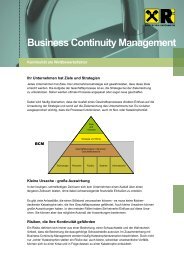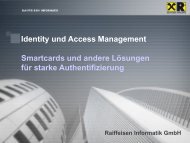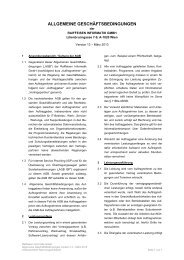ANNUAL REPORT - Raiffeisen Informatik
ANNUAL REPORT - Raiffeisen Informatik
ANNUAL REPORT - Raiffeisen Informatik
- No tags were found...
Create successful ePaper yourself
Turn your PDF publications into a flip-book with our unique Google optimized e-Paper software.
V.3. ECONOMIC RESPONSIBILITYV.3.1. SUSTAINABLE CUSTOMER ORIENTATIONIn times of economic turmoil, demands on companiesare constantly increasing. Outstanding service quality isthe best way to differentiate oneself from competitors.Sustainable customer orientation is the promise of acompany to provide customers with the highest possiblebenefits and act in their interests when serving themover the long term. Customers honour this sustainabilityeffort by long-term loyalty.As the largest and most secure data centre in Austria,<strong>Raiffeisen</strong> <strong>Informatik</strong> meets all quality, service and securityrequirements of customers. The claim of excellentperformance quality for customers is defined in thecorporate strategy within the balance scorecard conceptand is binding on every employee by a modern systemof target agreements. The quality of customer orientationand the services of <strong>Raiffeisen</strong> <strong>Informatik</strong> are reviewedregularly by written and personal surveys of customers.When the evaluations of customers start deteriorating,steps are immediately taken to optimize quality. Irrespectiveof this, the Group always endeavours to continuallyimprove the quality of service in all processes and auditroutines. In the case of failures of customer applications,special emergency teams are formed that are availableday and night to take action and remedy the problems asfast as possible.V.3.2. CHANGE MANAGEMENTThe significance of IT services for a company’s businessis constantly growing. Many business processes are notfeasible today without the use of IT or are alreadycompletely based on IT. With the increasing significanceof IT, the requirements of customers on IT serviceproviders are also becoming more demanding. IT serviceproviders have to face these challenges and develop newideas, concepts and methods. As markets call on the ITindustry to intensify their service, market and customerorientation, IT service providers are being forced torevise and/or change their business concepts. At the coreof this trend is the implementation of a service-orientedIT management.The primary goal of <strong>Raiffeisen</strong> <strong>Informatik</strong> is to design itsIT services to meet customer requirements and to ensurethe continuous monitoring and control of IT servicesto comply with customer needs. A successful changeprocess involves the replacement of the traditionaltechnology-based management processes by serviceorientedprocesses, and the exchange of reactiveprocesses by proactive components.Technological developments in the fast-paced IT industryinfluence the strategies and structures of the IT servicesector and ultimately how services are provided. Thesechanges encompass small, everyday changes as well asmore sophisticated ones to upgrade customer services.Disruptions to customer processes due to outdatedtechnologies are extremely critical and may cause enormousdamage and costs.As the largest IT service provider in Austria, <strong>Raiffeisen</strong><strong>Informatik</strong> always endeavours to respond to thesechanges quickly, efficiently, inexpensively and with thelowest risk possible. <strong>Raiffeisen</strong> <strong>Informatik</strong> providessupport for change processes by offering solutions thathelp optimize services, keep paths to customers short,and ensure the security of the change processes. Themotivation, information and integration of employees arethe key components to a successful change management.Therefore, the goals, roles and rules within acompany are defined clearly for every change process toenable employees to act efficiently in the interest ofcustomers.The role of the IT service provider itself has also changedover time. Based on the increasing homogeneity of ITservices, these have become easier to replace. Therefore,IT service providers have also become easier toreplace. Current trends illustrate this clearly such as thedevelopment away from single-sourcing in which allIT services are obtained from one IT service providertowards a multi-sourced environment, in which ITservices are procured from several IT service providersdepending on their specialization. Those IT serviceproviders are selected that offer the specific IT servicewith the desired functionality at the least expensiveprice and the best quality. <strong>Raiffeisen</strong> <strong>Informatik</strong> is a fullservice provider for most of its customers, which speaksin favour of the extensive services portfolio, and thequality and customer-orientation of its services.V.3.3. BUSINESS CONTINUITY MANAGEMENTThe objective of business continuity management(BCM) is to secure the smooth operation of the IT-basedbusiness processes of customers.Business continuity management (BCM) is a managementprocess that identifies the potential effects ofemergency situations and disasters on an organisation.In this context, a standardized, controlled mode ofprocedure is executed to prevent or at least minimizedamage in emergency exceptional situations. Maintainingundisrupted business processes at customers andquickly restoring operations in case of emergencyrequires a high degree of prevention. Business continuitymanagement requires a holistic approach. Apart frompreventive technical measures such as the creation ofredundant infrastructures, it is the task of every responsiblecompany to prepare for emergency situations and toensure a rapid response and effective action. <strong>Raiffeisen</strong><strong>Informatik</strong> meets this requirement by a clearly definedemergency and crisis organization which is able to takeimmediate action in the case of emergency. Speciallytrained emergency managers and crisis teams arecapable of responding as fast as possible to unexpectedevents. In case of emergency, they manage the resourcesneeded to fix a disruption to operations immediatelyand to guarantee the flow of information within thecompany and to customers. Proven emergency and crisisscenarios serve as basis for the identification and implementationof adequate preventive measures. Regulardrills of specific scenarios help to keep everyone awareof the possibility of an emergency and the actionsneeded.V.3.4. MODERN IT SERVICE MANAGEMENT (ITSM)Information technology is a key element in the valuechain of customers and therefore directly related to thesuccess of a business. The quality of service alwayshas priority at <strong>Raiffeisen</strong> <strong>Informatik</strong>. ITIL (IT infrastructurelibrary) is considered the best practices recommendationfor IT service management and describes the workflowsand procedures for managing IT services and IT productsefficiently and inexpensively. The introduction of anITIL-based IT service management is also a commitmentto greater customer orientation and higher transparencyof services in the value chain. This transparency isnot only of great significance for business and strategicreasons, but also helps to continually improve operationalpro-cesses. With ITSM, <strong>Raiffeisen</strong> <strong>Informatik</strong> guaranteesa high level of service quality that automatically alsoimplies a better competitive position.New technologies such as cloud computing make itcertain that ITIL conformity will gain even greater significancein the future. Cloud computing offers many differentadvantages to customers based on scalable computingperformance, software applications and infrastructures.The requirements of standardized IT processes to securethe quality of IT services are of key importance in thiscontext. ITIL conformity therefore changes from a nice-tohaveto a crucial competitive factor. With the introductionof an ITIL-based IT service management at <strong>Raiffeisen</strong><strong>Informatik</strong>, service orientation also receives greaterpriority in organizational deve-lopment.The main reasons why <strong>Raiffeisen</strong> <strong>Informatik</strong> has installedan IT service management system are cost efficiencythrough a harmonized system environment, improvedservices by better, standardized data quality, greater efficacyand efficiency in business processes, and the specificuse of automation technologies.These advantages are directly passed on to our customers.In 2012, the organization of operations wasredefined with the help the ITIL process model to meetfuture demands. Accordingly, more than 100 services inuCMDB were redefined and placed under the changecontrol of the ITSM system. This entailed the introductionof the ITIL processes for change management, configurationmanagement and service requests fulfilment.The introduction of these processes made it possible toreplace the order execution system RIOS. Orderexecution and control will be done exclusively in the newservice-oriented HP service management system.Financial Statements Certifications and Awards Risk Management CSR Group Management Report Group Profile Corporate Bodies / Shareholders Preface72 73












